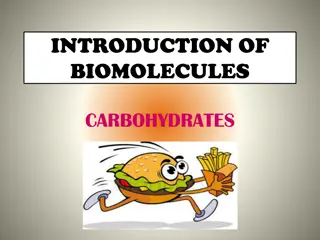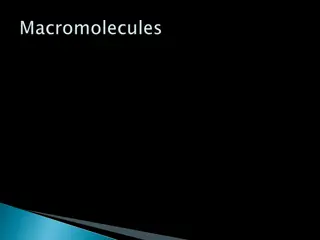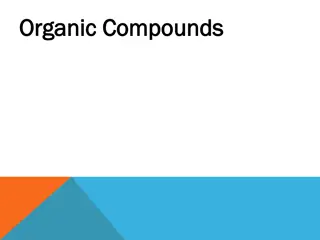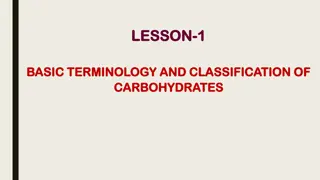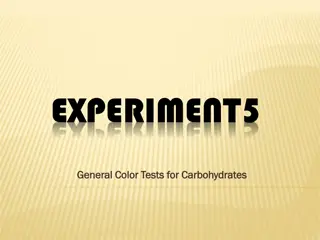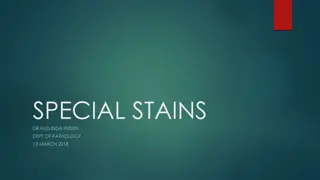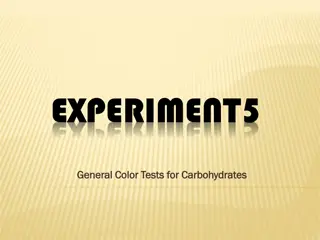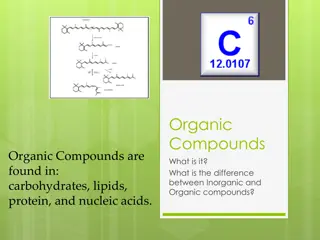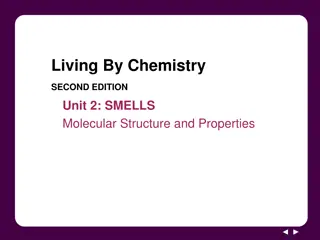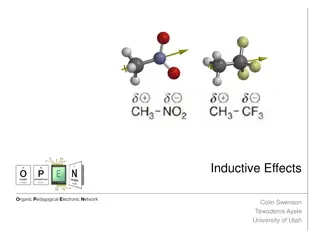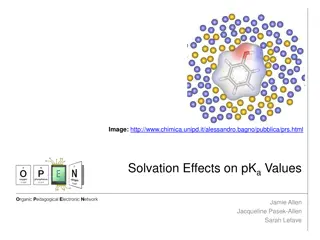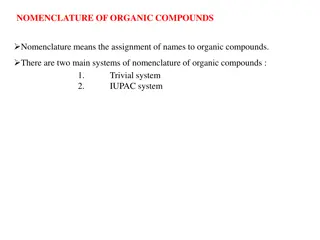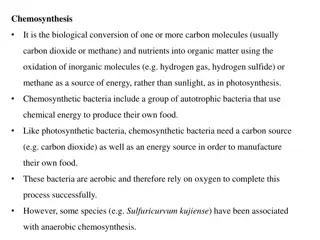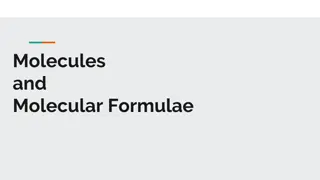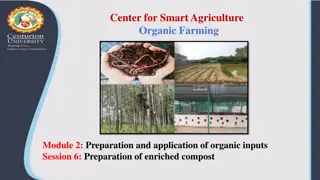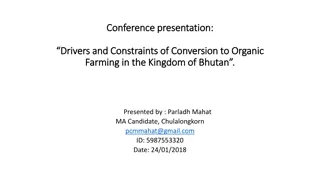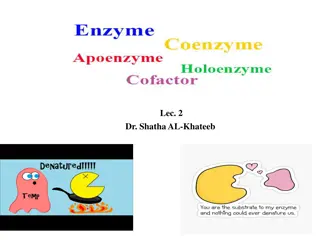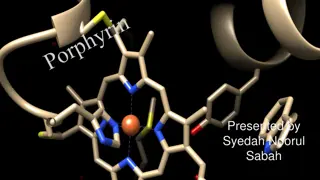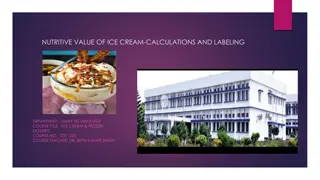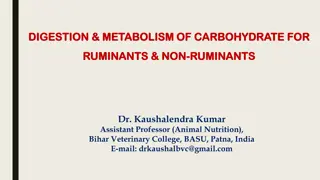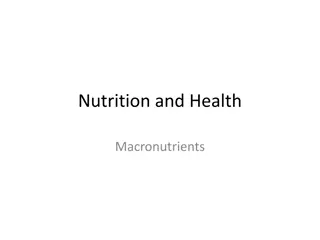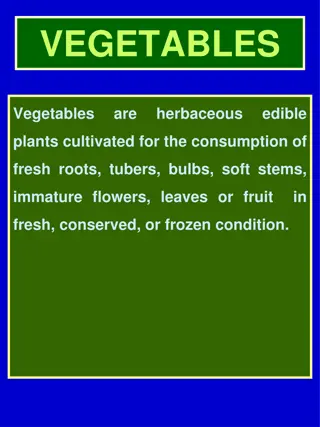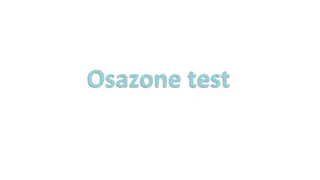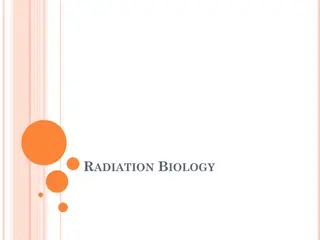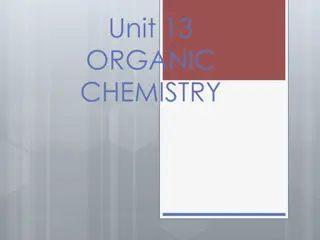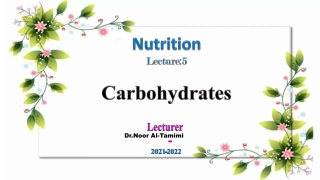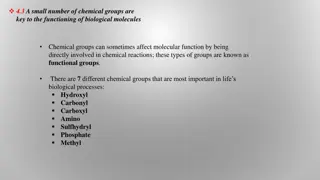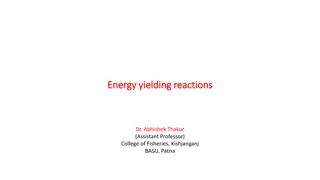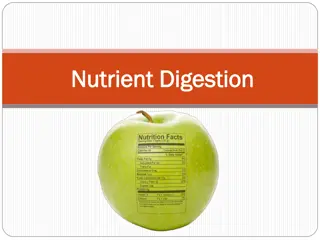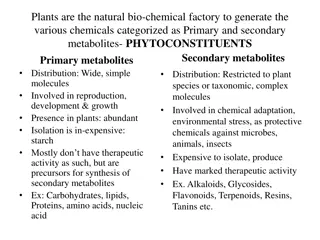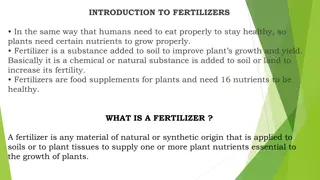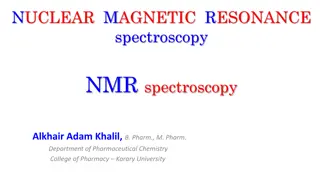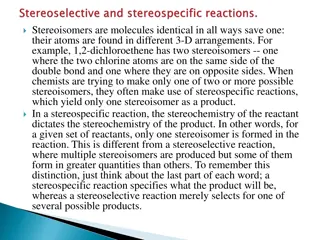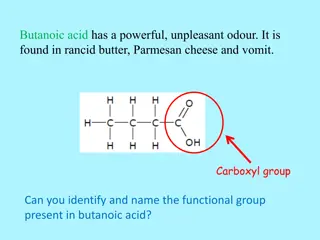Understanding Carbohydrates: Essential Organic Molecules in Nature
Carbohydrates, also known as saccharides, are crucial organic compounds that serve various functions in living organisms. They are a major energy source, play a role in energy storage, contribute to cell structure, and are essential components of DNA and RNA. Carbohydrates are classified into four groups based on the number of sugar units they contain: monosaccharides, disaccharides, oligosaccharides, and polysaccharides. Monosaccharides are the building blocks of carbohydrates and can be further classified based on the number of carbon atoms and the location of the carbonyl functional group. This classification helps in understanding the diverse roles carbohydrates play in biological systems.
Download Presentation

Please find below an Image/Link to download the presentation.
The content on the website is provided AS IS for your information and personal use only. It may not be sold, licensed, or shared on other websites without obtaining consent from the author. Download presentation by click this link. If you encounter any issues during the download, it is possible that the publisher has removed the file from their server.
E N D
Presentation Transcript
Carbohydrates or Saccharides Carbohydrates are the most abundant organic molecules in nature. Essential components of all living organisms. The word means "hydrate of carbon . The suffix ose indicates that a molecule carbohydrate, prefixes tri-, tetr-, and so forth indicate the number of carbon atoms in the chain. carbohydrate is a and the 2
Carbohydrates or Saccharides Carbohydrates compounds containing C, H, and O. The general formula for a carbohydrate is (CH2 O)n, where n 3. All carbohydrates contain C==O and functional groups. are OH D- Glucose D- Fructose 3
Functions of Carbohydrates 1. The major source of energy. 2. Acting as a storage form of energy in the body. 3. Serving as cell membrane component that mediate some forms of intercellular communication (e.g. cell adhesion in inflammation). 4. Serving as a structural component of many organisms, including exoskeleton of insects, and fibrous cellulose of plants. 5. Essential components of DNA and RNA (Ribose and Deoxyribose) cell wall of bacteria, 4
Classification of Carbohydrates There are four classes of Carbohydrates, based on the number of sugar units: Monosaccharide (simple sugars): cannot be broken down into simpler sugars under mild conditions. Disaccharides: contain 2 monosaccharide units covalently linked. Oligosaccharides: contain from 3 - 12 monosaccharide units covalently linked. Polysaccharides: contain more than 12 monosaccharid units and can be hundreds of sugar units in length covalently linked. 1. 2. 3. 4. 6
Monosaccharides or Simple Sugars Monosaccaharides are derivatives of straight - chain polyhydroxy alcohols containing at least three carbon atoms. Such substances, for example, D-glucose and D- ribulose, cannot be hydrolyzed to form simpler saccharides. aldehyde or ketone D- Glucose D- Ribulose 7
Classification of Monosaccharides Monosaccharides can be classified according to: 1. The number of carbon atoms they contain. Examples of monosaccharides found in humans. 2. The location of the carbonyl (CO) functional group: Aldose: monosaccharide has a terminal carbonyl group (O==CH-) called an aldehyde group. Ketose: monosaccharide has a carbonyl group (O==C) in the middle linked to two other carbon atoms, called a ketone group. Examples of an aldose (A) and a ketose (B) sugar. 8
Classification of Monosaccharides These terms may be combined so that, for example, glucose is an aldohexoses where ribulose is a ketopentose. aldo trioses and keto trioses aldo tetroses and keto tetroses aldo pentoses and keto pentoses aldo hexoses and keto hexoses D- Glucose D- Ribulose The simplest monosaccharide are the two 3- carbon trioses: Glyceraldehydes, an aldose Dihydroxyacetone, a ketose. 9
Classification of Monosaccharides The most abundant monosaccharides in nature are the hexoses, which include the aldohexose D-glucose and the ketohexose D-fructose. D- Glucose D- Fructose 10
Classification of Monosaccharides The stereochemical relationships, shown in Fisher projection, among the D-aldoses with 3 to 6 carbon atoms. The configuration about C2 (red) distinguishes the members of each pair. 11
Classification of Monosaccharides The stereochemical relationships among the D-ketoses with 3 to 6 carbon atoms. The configuration about C3 (red) distinguishes the members of each pair. 12
Chirality Chiral objects: cannot be superimposed on their mirror images e.g., hands, gloves, and shoes. Achiral objects can be superimposed on the mirror images e.g., drinking spheres, and cubes. glasses, 14
Chirality Any carbon atom which is connected to four different groups will be chiral, and will have two nonsuperimposable mirror images; it is a chiral carbon or a center of chirality. If any of the two groups on the carbon are the same, the carbon atom cannot be chiral. Many organic compounds (e.g. carbohydrates, amino acids) contain more than one chiral carbon. 15
Stereoisomers The central carbons of a carbohydrate are asymmetric (chiral) four different groups are attached to the carbon atoms. This allows for various spatial arrangements around each asymmetric carbon (also called stereogenic centers) forming molecules called stereoisomers. Chiral Centers Chiral Centers 24=16 steroisomers 23=8 steroisomers 16
Stereoisomers Stereoisomers have the same order and types of bonds but different spatial arrangements and different properties. For each asymmetric carbon, there are 2n possible isomers (e.g. an aldohexose asymmetric carbons, there are 24, or 16, possible isomers). contains four Chiral Centers Chiral Centers 24=16 steroisomers 23=8 steroisomers 17
Stereoisomers What is the maximum number of possible stereo-isomers of the following compounds? 18
D- and L- Monosaccharides (Stereoisomers) According to the conventions proposed by Fischer: D-monosaccharide: a monosaccharide that, when written as a Fischer projection, has the -OH on its asymmetric carbon on the right. L-monosaccharide: a monosaccharide that, when written as a Fischer projection, has the -OH on its asymmetric carbon on the left. 19
Isomers and Epimers Isomers are compounds that have the same chemical formula but have different structures. Fructose, glucose, mannose, and galactose are all isomers of each other, having the same chemical formula, C6H12O6. 20
Isomers and Epimers If two monosachharides differ in configuration around only one specific carbon atom (with the exception of the carbonyl carbon), they are defined as epimers of each other (of course, they are also isomers!). C2 epimers C4 epimers 21
Isomers and Epimers Glucose and galactose are C-4 epimers - their structures differ only in the position of the OH group at carbon 4. [Note: the carbons in sugars are numbered beginning at the end that contain the carbonyl carbon - that is, the aldehyde or keto group]. C2 epimers C4 epimers 22
Isomers and Epimers Glucose and mannose are C-2 epimers - their structures differ only in the position of the OH group at carbon 2. Galactose and mannose are NOT epimers they differ in the position of OH groups at two carbons (2 and 4) and are, therefore, defined only as isomers. C2 epimers C4 epimers 23
Enantiomers and Diastereomers Aspecial type of isomers is found in the pairs of structures that are mirror images of each other. These mirror images are called enantiomers. The two members of the pair are designated as a D- and L- sugar . The vast majority of the sugars in humans are D- sugars. 24
Enantiomers and Diastereomers Diastereomers: stereoisomers that are not mirror images (e.g. D-erythrose threose). Enantiomers: stereoisomers that are mirror images (e.g. D- erythrose erythrose). and D- and L- 25
Representation of Carbohydrates Structure 27
Representation of Carbohydrates Several carbohydrates: Fisher Projection. Haworth Projection. Chair Conformation. models are used to represent 28
Fischer Projections Fischer projections are a convenient way to represent mirror images in two dimensions. Place the group at or near the top and the last achiral CH2OH at the bottom. carbonyl 29
Fischer Projections Naming When there is more than one chiral center in a carbohydrate, look at the chiral carbon farthest from the carbonyl group: if the hydroxyl group points to right when the carbonyl is up it is the D-isomer. If the hydroxyl group points to the left, it is the L-isomer. Stereoisomers: 30
Fischer Projections Identify the following compounds as D or L isomers, and draw their mirror images: Fructose Xylose Arabinose 31
Configurations and Conformations Alcohols react with the carbonyl aldehyde and ketones to form hemiacetals and respectively. groups of hemiketals, 32
Configurations and Conformations A sugar with a 5-membred ring is known as a furanose in analogy with furan. A sugar with a 6-membred ring is known as a pyranose in analogy with pyran. 33
Cyclization of Monosaccharids The hydroxyl and either the aldehyde or the ketone functions of monosaccharides can likewise react intramolecularly to form cyclic hemiacetals and hemiketals. Cyclization using C1 to C5, results in hemiacetal formation. Cyclization using C2 to C5 results in hemiketal formation. In both cases, the carbonyl carbon is new chiral center and becomes an anomeric carbon. 34
Cyclization of Monosaccharids Fischer Projection: D-Glucose Has the aldehyde or ketone at the top of the drawing. The carbons numbered starting at the aldehyde or ketone end. The compound can be represented as a straight chain or might be linked to show a representation of the cyclic, hemiacetal form. are Fisher projection of glucose. (Left) Open chain (linear form) Fisher projection. (Right) Cyclic Fisher projection. 35
Cyclization of Monosaccharids Fischer Projection: D- Fructose 36
Cyclization of Monosaccharides Haworth Projection: Represents the compound in the cyclic form that is more representative of the actual structure. This structure is formed when the functional (carbonyl) group (ketone or aldehyde) reacts with an alcohol group on the same sugar to form a ring called either a hemiketalor hemiacetal ring, respectively. The reaction of (a) D-glucose in its linear form to yield the cyclic hemiacetal -D-glucopyranose, and (b) D-fructose in its linear form to yeild the hemiketal -D-fructofuranose. The cyclic sugars are shown as both Hawoth projections and space-filling models. 37
Haworth Projections A common way of representing the cyclic structure of monosaccharides Monosaccharides do not usually exist in solution in their open-chain forms: an alcohol group can add into the carbonyl group in the same molecule to form a pyranose ring containing a stable cyclic hemiacetal or hemiketal. All of the atoms on the right are pointed down in the Haworth structure. All of the atoms on the left are pointed up in the Haworth structure. 38
Cyclization of Monosaccharids In the pyranose form of glucose, carbon-1 is chiral, and thus two stereoisomers are possible: one in which the OH group points down ( -hydroxy group) and one in which the OH group points up ( -hydroxy group). These forms are anomers of each other, and carbon-1 is called the anomeric carbon. 39
Cyclization of Monosaccharids The new carbon stereocenter created in forming the cyclic structure is called an anomeric carbon. Stereoisomers that differ in configuration only at the anomeric carbon are called anomers. The anomeric carbon of an aldose is carbon 1; that of the most common ketoses is carbon 2. 40
Cyclization of Monosaccharids always above ring for D-saccharides Anomeric carbon 41
Chair Conformation The use of Haworth formulas may lead to the erroneous impression that furanose and pyranose rings are planner. Chair Conformation: The most stable conformation of cyclohexane that resembles a chair. The chair structure consists of a six-membered ring where every C-C bond exists in a staggered conformation. Molecules will try to adopt the most stable conformation that minimizes strain. 43
Chair Conformation When going from the Haworth projection to the chair conformation, the anomeric carbon s substituent that points down in the Haworth projection is going to be axial, and the substituent that points up in the Haworth projection is going to be equatorial. An axial OH on the anomeric carbon makes the sugar an sugar, while an equatorial OH on the anomeric carbon makes the monosaccharide a sugar. Besides the substituents on the anomeric carbon, everything else is drawn relative to the Haworth projection. In other words, all the other substituents are drawn pointing up if they were pointing up in the Haworth projection, and pointing down if they were pointing down in the Haworth projection. 44
Physical and Chemical Properties of Carbohydrates 46
Physical Properties of Monosaccharides Most monosaccharides have a sweet taste (fructose is sweetest; 73% sweeter than sucrose). They are solids at room temperature. They are extremely soluble in water: Despite their high molecular weights (MW), the presence of large numbers of OH groups make the monosaccharides much more water soluble than most molecules of similar MW. Glucose can dissolve in minute amounts of water to make a syrup (1 g / 1 ml H2O). 47
Chemical Properties of Monosaccharides Oxidation-Reduction Reactions: REDUCTION The carbonyl group of a monosaccharide can be reduced to an hydroxyl group by a variety of reducing agents, such as NaBH4. Reduction of the C=O group of a monosaccharide gives sugar alcohols called alditols. The products named by replacing the -ose ending with -itol. Reduction of D-glucose: 48
Chemical Properties of Monosaccharides Oxidation-Reduction Reactions: REDUCTION Reduction of D-fructose: D- Sorbitol (sugar alcohol) D- Fructose D- Mannitol 49
Chemical Properties of Monosaccharides Oxidation-Reduction Reactions: OXIDATION Monosaccharides are reducing sugarsif their carbonyl groups oxidize to give carboxylic acids. Oxidation of an aldose yielding an aldonic acid (suffix onic acid). Oxidation of D-glucose: 50


